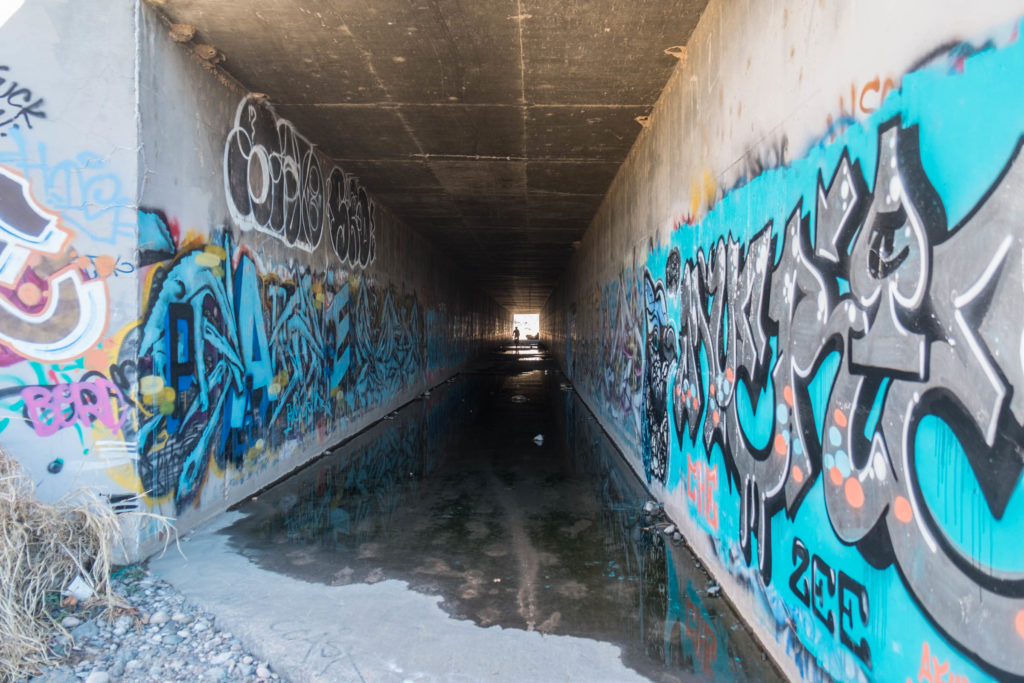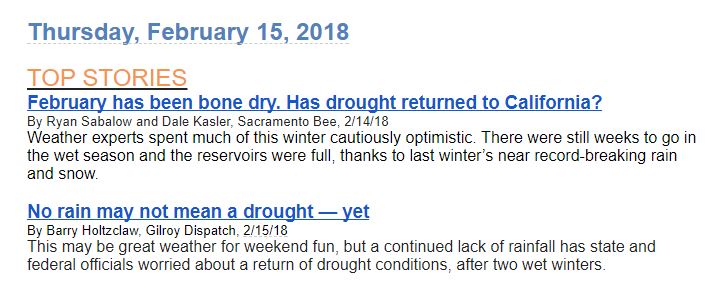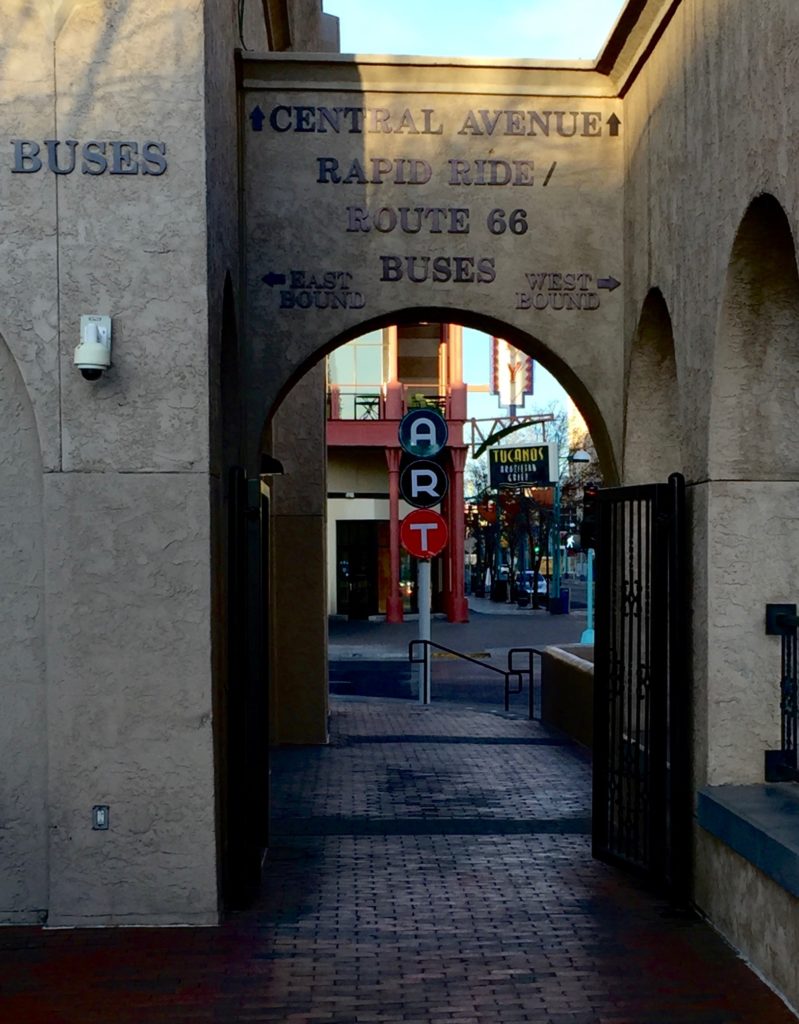We lost the daily direct flights between Albuquerque and Tucson a decade ago when the economy tanked, which left me in a shuttle yesterday morning at sunup driving north on I-10 from Tucson to Phoenix to catch a flight home after a couple of very intense, very productive days discussing water.*
It’s a beautiful stretch of desert, except when it’s not, capturing my ambivalence about life in the desert southwest – saguaros marching up the sides of rocky desert hills, the dry bed of the Gila River, spreads of nut orchards (pecans?), Central Arizona’s ever-present cotton fields, the spreading sprawl of Tucson creeping north and greater Phoenix heading south.
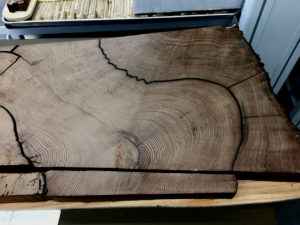
Tree rings, at the Laboratory of Tree-Ring Research, University of Arizona, Tucson
And of course all of this is tied up in my changing understanding of water. At this point in my life, it’s impossible for me not to map water onto the landscape, built or not, or conversely map the landscape onto the water.
It once would have been easy for me to tell this story, about what I was seeing as the Arizona Shuttle driver whisked us up the interstate, past the cotton fields and pecan orchards and sprouting subdivisions. My traditional, old school narrative could have easily riffed on how crazy it all was, that this is a desert and what Arizonans have done makes no sense.
The riff would have included the bizarre sight of “Lake Pleasant” on the north edge of the Phoenix metro area where they (we?) pump Colorado River water up a hill into a dammed desert canyon and then water ski on it (How crazy is that?), or the desert water writer’s obligatory observation about all the pools you see as your plane climbs out of Phoenix’s Sky Harbor International Airport.
173,500 acres of cotton (2017’s harvested acreage, up 34 percent from 2016) in a desert state like Arizona? Really?
Here you have the dilemma – a landscape of saguaros and irrigated cotton. We’ve made some strange choices. And yet those are the choices we made, and the question becomes what to do next.
And here Young John and Old John have parted company.
In my quest to better teach some critical communication skills to UNM Water Resources Program students, I’m in the midst of reading They Say / I Say, a popular text on academic writing. The book’s central bit of business revolves around the importance of having a work of rhetoric engage in dialogue with that which came before – start with what “they say”, and then offer your own argument in response.
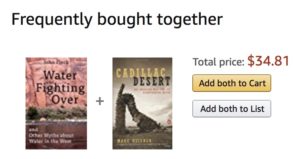
in dialogue
For me, to write about the Colorado River Basin, about water in the west, was to unavoidably enter into such a dialogue with Marc Reisner, whose epic book Cadillac Desert profoundly shaped Young John’s thinking. And so in the introductory chapter of my own book, I engaged Reisner in a very explicit way:
Reisner concentrated his fierce critique on what he saw as a corrupt process that overbuilt the West’s great plumbing system. The subtitle notwithstanding, Cadillac Desert spends little time on the “dis- appearing water,” or the actual human consequences of water shortages. But neither did Reisner shy away from apocalyptic rhetoric. In the 1993 afterword to the book’s second edition, Reisner was explicit. California had just experienced what was at the time its worst drought on record, which, Reisner said, “qualifies best as punishment meted out to an impudent culture by an indignant God.”
Like many who manage, engineer, utilize, plan for, and write about western water today, I grew up with the expectation of catastrophe. I first wrote about water shortage in California during that same late-1980s–early-’90s drought Reisner bemoans. But as drought set in again across the Colorado River Basin in the first decade of the twenty-first century, I was forced to grapple with a contradiction: despite what Reisner had taught me, people’s faucets were still running. Their farms were not drying up. No city was left abandoned.
I began asking the same question, again and again: when the water runs short, who actually runs out? What does that look like? Far from the punishment of an indignant God, I found instead a remarkable adaptability.
Thus when I point out that Arizona’s water use peaked around 1980, before the publication of Cadillac Desert, that last year’s Arizona cotton acreage was just 25 percent of its 1953 peak (source: USDA), that municipal water use in Arizona’s populated central valleys around Tucson and Phoenix declined from 2010 to 2015 even as their populations continued to rise (source: USGS), I am in a “they say/I say” dialogue not so much with Reisner as with my younger self.
Young John’s riff on the craziness of Lake Pleasant and swimming pools and irrigated cotton hard against the saguaros missed two important things with which Old John has made truce. The first is that the cotton fields and swimming pools bring genuine value to the people who chose them, who would prefer to keep them. The second is that, faced with scarcity, we have shown again and again the ability to back away from the water supply cliff, to use less water in a way that – and this is the crucial point – allows us to preserve a significant measure of that which we value.
Phoenix and Tucson (and Albuquerque), in all their strip malled sprawling glories, are not going away easily, nor need they.
And yet….
At dinner Friday night on Tucson’s west side – an impromptu dendro grad student/postdoc gathering (thanks Will!) – we had enchiladas and chile rellenos and talked megadrought.
Dendro people – those who use tree rings to tease out and help us think about ancient climates – have a particular and particularly useful vantage point on life in the arid landscapes of western North America. I’d make a joke about what a drag they are at parties as they eagerly point out that the west has experienced droughts far deeper and longer than anything in what we call “the instrumental record” – the period for which we have rain and stream gauges to measure how much water we have to work with. And that the risk of megadrought’s return is rapidly rising because of climate change.
But really, I love the people of dendro. Their story matters.
And I do not know how to answer their question about what happens under their megadrought scenarios. I can do some relatively straightforward arithmetic in response – the ability for city people to use X percent less water than they are using today, even after the conservation we’ve already done, the ability for farm communities to continue to exist while irrigating far less acreage. Those are the conversations we’ll need to have, and they are far more robust if we can get beyond the rhetoric of “punishment meted out to an impudent culture by an indignant God”.
I am the professional optimist of the Colorado River Basin, until I sit down with the dendro people. This could be hard.
* A huge thanks to Sharon Megdal of the University of Arizona’s Water Resources Research Center for hosting the visit and arranging a couple of really valuable chances to talk to members of the University of Arizona community, and Sarah Frederick, Bethany Coulthard, Will Tintor, and Kevin Anchukaitis of the Laboratory of Tree-Ring Research for some great bonus time.



